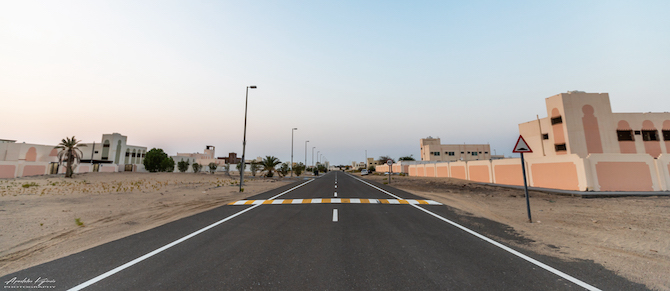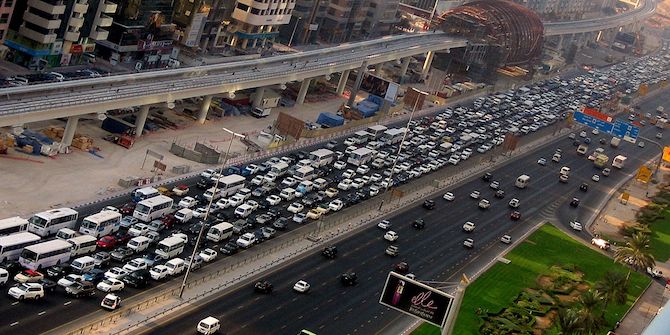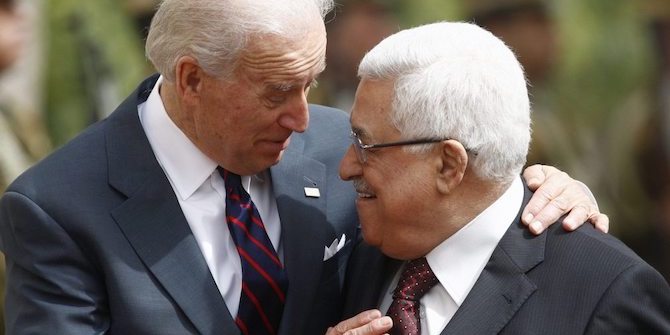by Alexandra Gomes, Apostolos Kyriazis, Clémence Montagne & Peter Schwinger

On 30 September 2021, we organised an online workshop titled ‘(Re)thinking Streets in Low Urban Densities’, hosted by the LSE Middle East Centre. The workshop formed part of an academic collaboration with Abu Dhabi University, on a research project titled ‘Roads as Tools for (Dis)connecting Cities and Neighbourhoods: a Socio-spatial Study of Abu Dhabi’. The project explores Abu Dhabi’s urban development and the role of road infrastructure in forging socio-spatial conditions.
The event brought together academics and experts to explore cities with low and very low densities, in search of incentives and motivations to shift urban planning and design practices that improve accessibility, walkability and the ability to operate public transport services within and between neighbourhoods. This is a fundamental topic for cities where urban form and car dependency make a vicious circle that is too solid to break. Indeed, this process is embedded in a social and spatial practice of not only urban life, but also urban development procedures, from decision and policy-makers to consultants, who draft future planning processes of mushrooming neighbourhoods. The call for case studies was open to different geographic spaces, yet focused on seeking relevance and correlations with the Middle East context.
During the workshop, academics joined us from the United Arab Emirates, Kuwait and Oman, but also from Mexico, Stockholm, the United States and India. The presentations explored the role of history and governance, planning and policy, and travel behaviour in low density developments. It also investigated the impact of suburban development on pedestrians, with particular focus on the gendered and safety-related aspects of their experience.
The first session dealt with city-level issues, with the primary goal to unpack methods that could help us explore policy change. The session explored the influence of historical and governance processes on urban form in Kuwait; methods of increasing permeability between the periphery and the centre using the case of Guadalajara; change in migrant and young adult’s travel behaviour in Stockholm, as well as a systems’ approach to transportation development and liveable cities through cost and investment analysis.
The second session focused on the local scale, specifically through cases studies from the Middle East. Topics addressed included issues related to the uneven distribution of public amenities that lead to spatial segregation in Dubai, and re-thinking the function of streets in Saudi Arabia. The two last presentations explored the experience of pedestrians in Oman, focusing on safe and active mobility, as well as the impact of health-oriented urbanism on women’s physical activity. The main objective of this session was to explore research within the Middle East, as well as the impact of participatory methodologies in leading experimentations that change the management of urban and transport policy.
The event concluded with a roundtable session around the case of Abu Dhabi. Participants questioned urban planning and design tools, raised good examples regarding the re-development of existing suburbia, and highlighted the challenges of policy change.
This was an important and engaging discussion exploring complex questions and methodologies from existing case studies, while also brainstorming for future ideas and scenarios. This blog series features summaries of the participants’ fascinating presentations, integrating some of the outcomes and insights that emerged from the workshop.
This piece introduces a series on urban development and the role of road infrastructure in forging socio-spatial conditions, based on contributions from participants in a closed LSE Roundtable in September 2021. Read the introduction here, and see other pieces below.
In this series:
- (Re)thinking Streets in Low Urban Densities by Alexandra Gomes, Apostolos Kyriazis, Clémence Montagne & Peter Schwinger
- The Future Development of the City of Kuwait: Kuwait’s Urban Form as a Case Study by Roberto Fabbri
- Pedestrian Dynamism Index: An Approach to Increasing Permeability between the Peripheral and Central City of Guadalajara by Monica Castañeda, Ricardo Fernandez and Roberto Robles-Arana
- Studying Abroad in Stockholm: Incentivising Young Adults Towards Greener Mobility by Ningning Xie
- Plan with a Purpose: A Systems Approach in Transportation Development and Liveable Cities by Lizao Chen
- Metropolisation and Spatial Segregation in Gulf Cities: The Cases of Abu Dhabi and Dubai by Moiz Uddin
- Rethinking Streets in North Obhur, Jeddah, Kingdom of Saudi Arabia by Alok Tiwari
- Safe and Active Mobility: A Prototype for the Re-Pedestrianisation of Residential Neighbourhoods in Oman by Gustavo de Siqueira
- Urbanisation and Physical Activity: Addressing the Needs of Omani Women by Ruth Mabry and Huda Al Siyabi







8 Comments